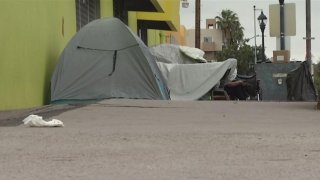
Mayor Todd Gloria and County Board of Supervisors Chair Nathan Fletcher detailed Friday a new two-phase strategy to address homelessness, particularly those dealing with chronic homelessness and substance abuse disorder.
The local leaders said they would be dedicating nearly $100 million to services and outreach programs that are meant to cater specifically to unsheltered individuals with the most unique needs.
"Homelessness is the most pressing challenge facing our region," Gloria said. "The city and county are in lockstep and fully committed to implementing sound policies and proven strategies that will make a transformational difference in the lives of people who are homeless."
The first phase of the strategy will begin June 28. Outreach teams will hit the streets for a coordinated and geographically concentrated, monthlong outreach campaign to connect individuals who are experiencing homelessness to immediate shelter and other services.
Get San Diego local news, weather forecasts, sports and lifestyle stories to your inbox. Sign up for NBC San Diego newsletters.
The first phase of the strategy, scheduled to begin on June 28, relies on a fleet of outreach workers from PATH, the Downtown San Diego Partnership, Father Joe’s Villages and Alpha Project who will first be deployed in central San Diego before expanding to other parts of the county.
This area, according to the San Diego Regional Task Force's annual Point in Time County, currently and historically comprises the largest concentration of people experiencing homelessness, the city said.
"Each person experiencing homelessness has their own unique set of circumstances, but addiction and mental health injury are common contributors to chronic homelessness, requiring a distinct response to meet their particular needs," Fletcher said. "We are investing in a better way, an approach that is different from what we have done in the past. We expect to achieve better outcomes with this strategy."
Local
The teams will provide outreach and engagement, connection to primary care and behavioral health services, and bridge housing, including Safe Haven housing, to individuals with chronic substance-use and mental health conditions.
The outreach teams will be supported by county public health nurses and social workers from the Office of Homeless Solutions and Equitable Communities, who will provide onsite support with public assistance programs. The San Diego Police Department's Homeless Outreach Team will participate in a supporting role, including transportation and logistics.
The mayor also said capacity would be expanding at four shelters for people experiencing homelessness, now that the lifting of COVID-19 precautions has allowed for more capacity. In the coming weeks, roughly 300 beds will be added at the Paul Mirabile Center, two East Village shelters and Connections Housing -- bringing total capacity to around 1,400 beds.
In Phase 2, Community Harm Reduction Teams (C-HRT) will engage people with highly complex and acute needs who are experiencing homelessness and at increased risk of harm due to substance use and mental health conditions, according to the city.
The teams will provide substance-use counselors, peer support, mental health clinicians, and psychiatric consultation with nurse practitioners. They will also link unsheltered individuals with specialized temporary housing, regardless of the status of their sobriety. The city said there are currently no shelters for those who are not sober or actively committed to sobriety.
The county and city will dedicate American Rescue Plan Act funds to this effort.
A total of $10 million of the city's budget is dedicated to funding for operational costs of the expanded shelter space and safe haven and other complementary programs, and additional federal and state resources will support the acquisition of permanent supportive housing.
The county will provide funding for C-HRT teams, along with behavioral health and support services at the new bridge shelter and Safe Haven sites.
The county will also explore the availability of more short- and long-term housing resources countywide that align with the harm reduction strategy.



